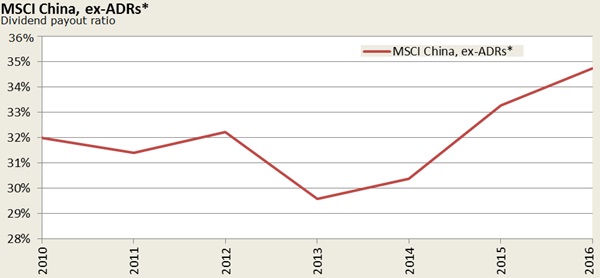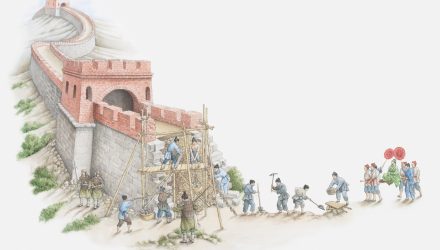In our view, this change of mindset in raising dividend payouts is positive on a few fronts:
- Channeling cash to the government through their major ownership. Higher dividend payouts from SOEs may alleviate stretched fiscal conditions and provide support to government programs, such as the restructuring of weaker SOEs.
- Enhancing return on equity (ROE) through better cash management. Paying out dividends is a direct way to reduce cash balances and shareholders’ equity, which raises ROE. Secondly, by deploying a proper dividend policy, the management could focus on more efficient utilization of resources.
- Raising cash returns to minority shareholders, which in general helps lift valuations. We believe a company’s future cash payouts ultimately determine its value to equity shareholders. Rising dividend payouts can meaningfully boost shareholders’ total return and help drive re-rating of shares.
In fact, when tracking constituent stocks in the MSCI China Index (ex ADRs), which has a high bias toward SOEs such as banks, insurance, energy and materials, there has been a clear upward trend in the dividend payout ratio since it bottomed out in 2013. The ratio increased from a weighted average of 29.5% in 2013 to 35% in 2016.2

Past performance is not a guarantee of future results. An investment cannot be made directly in an index. *Note: The calculation above excludes American Depository Receipts (ADRs), which represent about 25% of the MSCI China Index. As they were added into the index in two phases in 2015 and 2016, we excluded them for better comparison.
Mixed-ownership reforms to enhance corporate governance
With an aim to tap into private capital and reinvigorate SOEs, we believe mixed-ownership reform has become increasingly important to the central government’s overall reform initiatives.
During the 19th Party Congress, Chinese President Xi Jinping stated that China will continue to improve the state-owned asset management system, and highlighted the importance of deepening SOE reforms and promoting mixed ownership to foster world-class enterprises.
Related: Why the U.S. Debt Problem is Getting Worse
Under mixed-ownership reform, an SOE will invite some strategic investors, normally the industry’s leaders, to purchase its equity shares. Through the alliance, it can utilize the investors’ resources, both financial and human, to explore new opportunities. Additional members nominated by the strategic investors will be added to the board, participating in key decision-making and the enhancement of corporate governance.
Management will be awarded with stock options based on key performance targets to align their interests with the company’s. By lowering its percentage of ownership, the government reduces its influence over an SOE.
The Chinese government has rolled out two batches of mixed-ownership reform pilots since the second half of 2016, featuring leading SOEs in a variety of industries.
More than a third of those companies had successfully attracted outside investors, restructured corporate governance, and established internal reward and recognition systems by late 2017. A third batch is expected to soon be unveiled.
Visible improvement in financial conditions
We believe the government’s focus on reforms will create a long-term impact on SOE profitability and help contain the high leverage associated with them. Indeed, there has been noticeable improvement in financial conditions of SOEs recently. In 2017, the net profits of all central SOEs delivered positive growth of 16%, the highest level in five years.3 Together with tightening regulations on bank lending, the government has managed to slow the rapid expansion of SOE debt. The ROE of Chinese SOEs has also improved, reversing the deterioration that began in 2010.4
Conclusion
Contrary to the aftermath of the financial crisis in 2008, when easy credit and large amounts of stimulus funding were made available to many SOEs, the top leadership nowadays places a greater emphasis on the quality of growth with an objective to improve the competitiveness of the state sector.
The stable macroeconomic environment also allows the government to be more tolerant toward the downward risks on economic output and employment that used to be associated with SOE reforms. That said, given China’s gradual approach to SOE reform, it remains to be seen when the political and social environment will be ripe for more drastic reduction in the state’s influence.
Overall, we think the government is making good progress and is on the right track in the areas discussed above. We believe SOE reforms will continue to be a top policy agenda after the 19th Party Congress, and investors should closely monitor the implementation of relevant reform measures.
This article has been republished with permission from Invesco Powershares.

